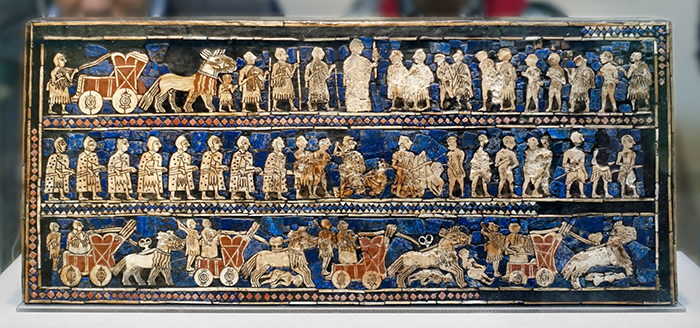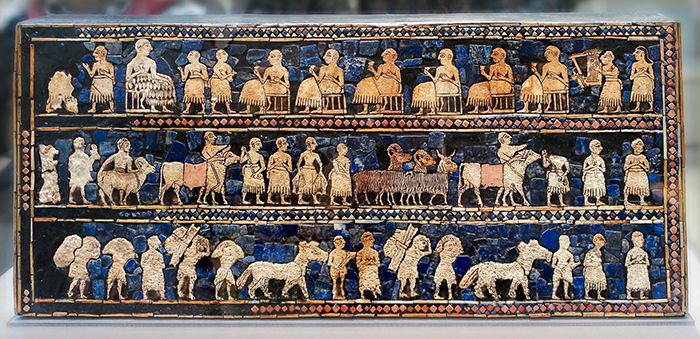What Best Describes the Standard of Ur
There two main sides to the Standard one side depicts a battle scene while the other seems to represent a society in relative peace. The Standard of Ur has stone glass and lapis lazuli like a mosaic.

Divergent Divergent Quotes Divergent Book Divergent Series
Leonard Woolley the excavator at Ur imagined that it was carried on a pole as a standard hence its common name.

. The bottom register of the. The Standard of Ur is a Sumerian artifact of the 3rd millennium BC that is now in the collection of the British Museum. The Standard of Ur was created in 2600-2400 BCE.
Thats not so different than this object that were looking at thats nearly 4500 years old an object known is the Standard of Ur which comes from the city-state of Ur which is now in present day Iraq. He did not want love of humans to compete with love of God. It has two main panels the War panel and the Peace panel.
C The author uses formal language and technical. European countries rejected immigration to preserve one dominant culture in each. Cultural diversity within wealthy western European countries has increased.
This theory soon fell out of favor. Which statement BEST describes the authors use of vocabulary appropriate for his audience and his purpose. According to your textbook why did Paul condemn sexuality.
Synonyms for best of the best include cream of the crop crème de la crème aristocracy beau monde beautiful people cream of society haut monde high society privileged class and smart set. According to the Christian Bible what best describes Jesus view on sexuality. Another theory suggests that it formed the.
This small trapezoidal box has two sides one panel known as the war side the other the peace side Each panel is in three registers. All the people are in rows. Standard of Ur The First Cities and States 4000 - 2000 BC Episode 2 of 5 Neil MacGregor describes the discovery of mosaics from the ancient Mesopotamian city of Ur now in Southern Iraq.
But its decoration is of great interest. I think this one C. Its original function is not yet understood.
Some scholars have thought it might be a musical instrument. Immigrants bring wealth and skills that have helped lower government costs for health care. Prisoners are brought before a larger individual who is accompanied by guards and has his own waggon waiting behind him.
And The Standard of Ur. As explained in The Standard of Ur. It has a front and back the War side and the Peace side.
King the Sumerian king and the enemy kings all carry standards. The Standard of Ur is a wonderful example of Mesopotamian artistic achievement that reveals a wealth of information about one of the worlds great. Others think it may be the sounding box of a lyre.
This object was found in one of the largest graves in the Royal Cemetery at Ur lying in the corner of a chamber above the right shoulder of a man. He taught that men should be held to the same standards of adultery divorce and remarriage as women. A The author uses casual informal vocabulary and quotations from American leaders to connect to his audience.
The purpose of the object remains unknown. The piece is a war standard which was carried on a pole through the Sumerian town to celebrate a war victory. Now the fallen standard lies between his feet.
The Standard of Ur was found in one of the largest royal tombs in the Ur cemetery PG 779 associated with Ur-Pabilsag. The word standard is a little misleading because a. Mosaic scenes little precious stones laid to make a recognizable pattern or in this case to tell a story made from shell red limestone and lapis lazuli set in bitumen give us the skinny on some objects within the Royal.
The decoration on each side is divided into three levels registers which can be read from. Which of the following best describes the impact of immigration on Europe during the 1900s. Ground lines and registers are used to show separation between parts of the.
Early example of an official account of import goods. An appreciation for the. This may be a depicition of a well-known event in the battle long since forgotten when the Sumerian king.
Early Christianity led to all of the following EXCEPT. The Standard of Ur. B The author uses Standard American English and metaphors to connect to his audience.
Recent scholarship suggests that the standard is possibly a sound box for a musical instrument. The Standard of Ur decorated on four sides with inlaid mosaic scenes made from shell red limestone and lapis lazuli set in bitumen. It dates to the First Dynasty of Ur during the Early Dynastic period and is.
Early example of historical narrative. The War panel of the standard depicts the defeat of an unknown enemy. The battle scene has come to be known as the War side of the Standard revealing a great deal.
It has kept that name but its hard to see how it could have been a standard of that sort because its obvious that the scenes are meant to be looked at from very close up. It was buried in a royal grave. Woolley though it might have been mounted on a pole and carried hence its name.
Each mosaic dubbed War and Peace presents a series of scenes displayed in three registers. It comes from the ancient city of Ur. This is how it is.
They use conceptual representation the best way to see the body is from the front while the best way to see the face is profile. The Standard of Ur is one of the most significant works from the Royal Cemetery. Woolley called it the Standard of Ur because he thought it might have been a battle standard that you carried high on a pole in a procession or into battle.
Early example of an official account of the rulers of Sumer. The Standard of Ur is a box the two large sides of which show aspects of life in early Mesopotamia. The enemy king pictured above proudly carried aloft his battle standard going into the battle.
Standard was usually a flag brought into battle in war- art historians hypothesize that this standard was once on a pole and. Early example of mythological narrative. In Mesopotamia really the birthplace of civilization and Ur is one of the great early cities.
The Standard both through its depictions and physical construction reveals a great deal about the organization of Early Dynastic Sumerian society. The Standard of Ur is a hollowtrapezoidal-shaped mystery box Woolley never figured out what it was for. One side shows a war scene.
Which of the following best describes the Standard of Ur. It is made of wood inlaid with shell lapis lazuli and red limestone and is approximately 85 inches high by 195 inches long. Carried aloft on a pole.
It comprises a hollow wooden box measuring 2159 centimetres wide by 4953 centimetres long inlaid with a mosaic of shell red limestone and lapis lazuli. It has been reconstructed as a hollow wooden box with panels inlaid with a mosaic of shell red limestone and lapis lazuli covering each long side. Woolley therefore thought it was a standard the kind that was carried in front of the troops in battle or during ceremonial processions of the king.
A Sumerian army with wheeled waggons and infantry charges the enemy. The Standard of Ur is the earliest depiction of a vehicle with wheels What the Standard of Ur was used for remains a mystery but it seems to have royal connections. Hence the name the Standard of Ur.

Standard Of Ur And Other Objects From The Royal Graves Article Khan Academy

Standard Of Ur And Other Objects From The Royal Graves Article Khan Academy


0 Response to "What Best Describes the Standard of Ur"
Post a Comment